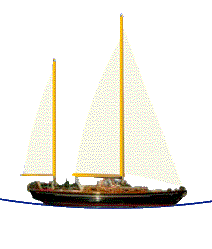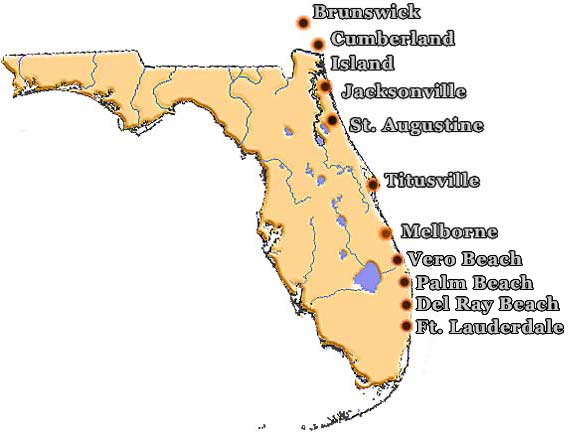


Ships Log
February16-25, 2006
St. Augustine, Florida
When the weather cleared, we left Jacksonville with the departing warship fleet and sailed down the coast to St. Augustine. We approached the St. Augustine inlet with some trepidation because the charts do not show the depth or channel markers. This is because the channel shifts frequently and the Coast Guard moves the marker buoys to fit the new route. Once we arrived at the first sea buoy, the channel was clear.
The first thing we could see was the St. Augustine light house of 219 steps. Next, we saw the 208 foot Nombre de Dios cross marking the mission founded on the spot where Don Pedro Menendez de Aviles landed on September 8, 1565, founding the city.
At the head of the inlet stands Castillo de San Marcos. We passed under the Bridge of Lions and took a slip at the Municipal Marina. The dock hand told us that he took the same slip several years ago and never left town because St. Augustine is such a charming place. The marina is in the heart of the historic district of this oldest city in the United States. St. Augustine was founded 42 years before the English colonized Jamestown (see Jamestown/Hampton web page).
At the time Menendez arrived on these shores, the native Timucua people and their ancestors had been living there for thousands of years. The Spanish brought disease and suffering. The native people were converted to Catholicism and forced to work building the fortifications and supporting the colony. The population was decimated.
The Castillo de San Marcos (1672) is the best example of Spanish fortification in the United States. It was constructed of coquina stone, which is made up of seashells compressed over millions of years. The stone was quarried by the Spanish on nearby Anastasia Island. The engineer Ignacio Daza laid out the fort as a star with a center square.
Slaves escaping from English plantations to the north were granted emancipation by the Spanish in return for conversion to the Catholic faith and service in the militia. They were allowed to construct Fort Mose out of earth and wood three miles north of St. Augustine Their leader was Francisco Menendez who arrived in 1724. One hundred men women and children lived in the community which was the first free black settlement in what is now the United States.
The fort was never taken by force and withstood several attacks from the English, including one by General Oglethorpe in 1740. It was given to the English along with the rest of Florida at the conclusion of the French and Indian War in 1763 in trade for Cuba.
The fort and Florida were returned to Spain in 1783 after the American Revolution. America took possession of the fort in 1821 and named it Fort Marion. It was used to imprison Native Americans during the Seminole War of 1835 to 1842. It was later used to imprison members of western Native American tribes.
During the English occupation, 1400 Greek indentured workers were brought to support the colony in New Smyrna 60 miles to the south. Fleeing the Turks, they sought freedom in the new world. However, they found the conditions deplorable, and died in large numbers. At the end of one year, fewer than 600 remained; they revolted and walked to St. Augustine and formed a new community centered around Casa Avero.
The city has retained a strong sense of living history. Everywhere we looked stood beautifully maintained original buildings such as the Rodriguez Avero-Sanchez house which was built in 1753 of coquina stone. The Segui-Kirby Smith house, built in 1788, is a good example of Spanish colonial design. The Prince Murat house (1790) was named after the nephew of Napoleon Bonaparte, who rented the residence. The Ximenez-Fatio house was constructed in 1798 by the Spanish merchant whose family lived over the general store.
Walking down the streets of St. Augustine, you feel transported to an 18th Century Spanish city. There is a Spanish Quarter living history museum. Here you may encounter a leather craftsman, a blacksmith, a church scribe, a wife of a soldier, or a carpenter. Over lager and hard cider at the authentic candle lit Taverna del Gallo we listened the bawdy sea shanties of the "Bilge Rats".
In the 1880's St. Augustine became a resort community and Henry Flagler built two hotels, the Ponce de Leon and the Hotel Alcazar.
You cannot leave St. Augustine without a visit to the mythical Fountain of Youth sought by Ponce de Leon in 1513, who gave Florida it's name and the Spanish the claim to the territory. It is said that no one has ever asked for a second drink of the sulfurous mineral water from the fountain. Looking into the mirror upon returning from the Fountain, we agree that we look young for the 16th century.
v
